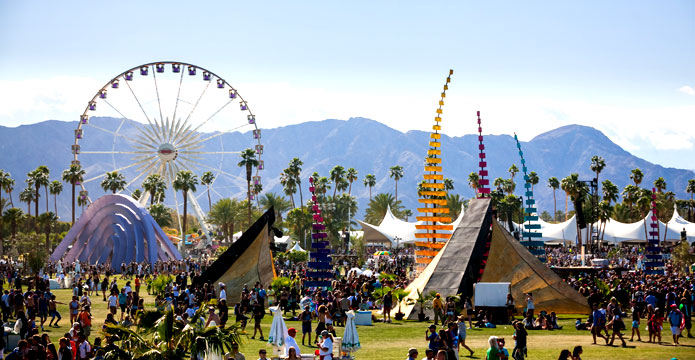
The major music festivals of today are the antithesis of traditional 1960s hippie folklore.
It’s not that these two to four-day events are without peace, love and happiness. Instead, the difference lies in the price tag. While you’re snapping selfies in your flower crown and drinking beer out of a camelback, you’re contributing to a thriving billion-dollar love child of corporate America. Festival attendees are definitely no longer “sticking it to the man.”
Event producers, advertising sponsors and booking agents have successfully monetized every aspect of the “festival experience,” from the actual ticket to the branded festival grounds themselves. When did festivals become more about money than music?
Humble Beginnings
Fifteen years ago, Coachella was a sparsely attended desert rave of 1,500 people, while Burning Man was an experience exclusive to just 80 “free spirits who surf [ed] the bleeding edge of culture, space and time.”
Today, that’s no longer the case. Music lovers from all walks of life can choose from Lollapalooza, Bonnaroo, Electric Zoo, Electric Daisy Carnival, Hangout Fest, Firefly, Electric Forest, Tomorrowland, Governor’s Ball, Austin City Limits, Riotfest and hundreds of other festivals.
Music journalists attribute this renewed interest in live music to the dissociative aspects of technology. “While downloading may have sapped music sales, it’s only amplified people’s desire to experience music up close and personal,” explains LA Weekly’s Chris Parker.
With this invigorated interest comes a thriving live music industry.
Take Coachella. In 2013, the California-based event was the most profitable music festival in the U.S., selling out all 158,000 tickets in 20 minutes. According to Billboard Boxscore, it pulled a total of $47.3 million in revenue, which led event organizers to expand the festival to two weekends.
Coachella wasn’t alone. Bonnaroo out of Manchester, Tennessee quickly sold out of their $269 apiece tickets, offering a VIP package for a casual $1449.50. Burning Man, a traditionally “anti-capitalist” event, generated around $25 million in 2014 ticket sales alone.
Corporate Sponsorship
Music festivals are now a large piece of the advertising puzzle, and marketers are all vying for a bite.
Seen as life changing experiences, brands see immense value in shaping the music festival experience. “If you’re a brand you want to be associated with someone having a transformational moment in their life,” explains co-creator of Bonnaroo Chad Issaq, VP of Business Development and Partnerships at Superfly Productions.
According to a report from IEG, an estimated $1.34 billion was spent sponsoring music festivals in 2014. FRUKT, an agency dedicated to finding branding opportunities within pop culture, reports that some 447 brands played a role in 300 music festivals worldwide in 2013. Coca-Cola Co., Anheuser-Busch and PepsiCo, Inc. are among the most active sponsors, with 27 percent of festival properties reporting partnerships with Coca-Cola.
Some brands even go as far as producing their own music festivals, such as the Red Bull Music Academy in New York and Budweiser’s Made in America festival out of Philadelphia and Los Angeles. Brands see value in “owning” the music festival experience, hoping attendees will associate their companies with positive memories.
There’s more to sponsorship than just logo placement. Garnier provided sweaty festival-goers with hair washing stations at Bonnaroo, while Mattel offered gaming tents for those in need of a dancing break. Alcohol companies also see large opportunity within the popular EDM music genre, creating marketing and advertising campaigns around safe consumption at festivals. Most notable was Heineken’s popular “Dance More, Drink Slow” theme.
Effect on Local Economies
Music festivals also have a profound financial effect on local economies.
Typically held in small or reclusive towns, successful festivals can bring in anywhere from 10,000 to 90,000 concert goers in one weekend. This influx of people in otherwise scarcely populated towns packs a powerful financial punch.
Both the Coachella and Stagecoach music festivals created 3,000 temporary jobs and brought $254 million into the Indio, California economy in 2012. Restaurants, hotel managers and convenience stores prepare for festival season weeks beforehand, bringing on part-time employees, extending business hours and raising prices. According to Coachella Valley news channel KMIR, local businesses and hotels reap most of the benefits, with profits increasing by 20 to 30 percent during those three weeks.
For the Money or the Music?
Although currently considered “one of young Americans’ favorite pastimes,” music festivals are no longer the embodiment of rebellion and freedom. Compared to the legendary Woodstock festival of 1969, tickets today are roughly 60 times more expensive, bands are paid 20 times more and production value is largely monetary. Unfortunately, attending a festival is just as contingent upon your current financial situation as your love of music. [Huffington Post]

